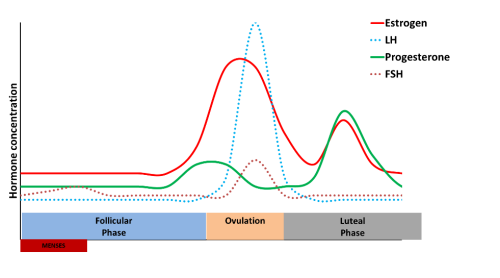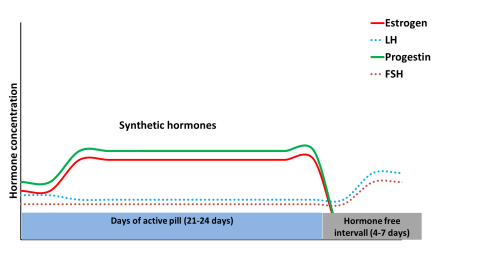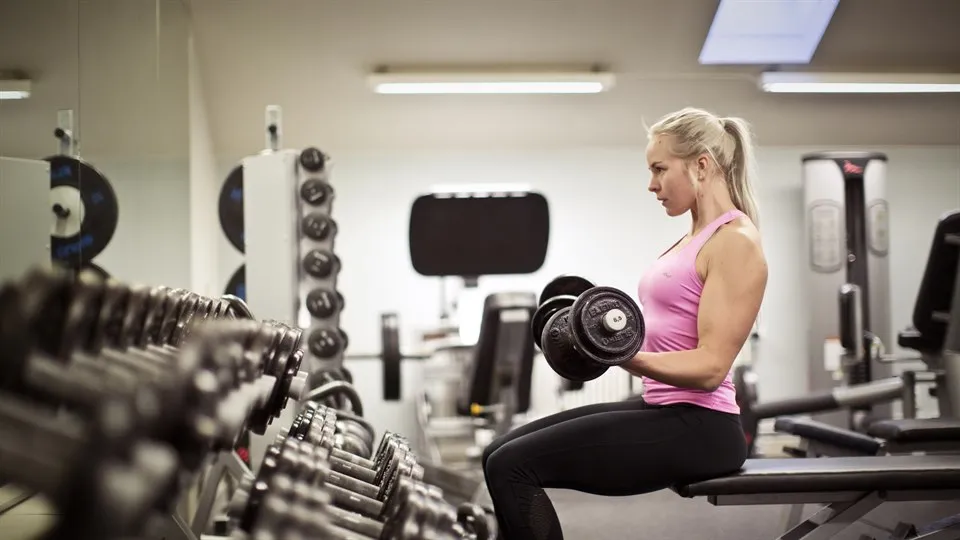The menstrual cycle and female athletic performance
In a recent study, more than half of elite female athletes reported that hormonal fluctuations during their menstrual cycle negatively affected their exercise training and performance capacity.
While the unique physiology of female athletes may require tailored training approaches that differ from those required for male athletes, the topic has historically been ignored and even considered somewhat taboo. However, female physiology and training has certainly been discussed among female athletes and coaches in practice and, fortunately, the world of sport is now beginning to embrace this important distinction between the sexes.
One of the characteristics distinguishing males and females is the difference in dominant sex hormones: estrogen and progesterone for females and testosterone for males. In females, these hormones are responsible for maintaining a healthy menstrual cycle and contributing to bone health, and they ultimately have an influence on performance.
In a recent study, more than half of elite female athletes reported that hormonal fluctuations during their menstrual cycle negatively affected their exercise training and performance capacity. On the other hand, it has been previously reported that Olympic Gold medals have been won by females during all menstrual-cycle phases.
What is the menstrual cycle?
The menstrual cycle starts with menses, when females are (unless they have become pregnant) bleeding and shedding the uterine lining. Menses is the start of the follicular phase, or “low hormone” phase, characterized by low luteinizing hormone (LH), follicle stimulating hormone (FSH), progesterone and slowly increasing levels of estrogens. This phase lasts for around the first 14 days of the menstrual cycle. Then around the "middle" of the cycle ovulation should occur, which is characterized by a spike in levels of estrogen and luteinizing hormone. This coincides with the release of the egg and is the time of the menstrual cycle when females can become pregnant. Ovulation is followed by the luteal phase and is the high-hormone phase of the menstrual cycle when both estrogen and progesterone levels are higher.

Figure 1. Hormonal fluctuations during the menstrual cycle (modified from Senanayake and Potts, 2008)
How the menstrual cycle may affect female athletic training and performance
A recent study indicated that approximately 75% of athletes experience negative side effects due to menses. The most common side effects include cramps, back pain, headaches, and bloating. Research also indicates fluctuations in strength, metabolism, inflammation, body temperature, fluid balance and injury risk that are concomitant with hormonal fluctuations throughout the cycle. However, the way in which the menstrual cycle affects females and their performance is highly individual and a number of studies indicate no differences across the cycle.
The potential effects of hormonal fluctuations throughout the menstrual cycle on various types of training and adaptations to training are summarised below:
Follicular phase
- Due to higher pain tolerance and experience of higher perceived energy levels, especially during the early follicular phase, this is the time where the female body is primed for high-intensity workouts.
- The rise in estrogen during the late follicular phase is suggested to hamper pre-exercise carbohydrate storage. Therefore, carbohydrate loading the day before and during exercise might be important for female endurance athletes to be able to exercise at high intensities.
- As estrogen levels are higher during the late follicular phase it has been suggested that strength training might be more effective,
Ovulation
- This could be the time to achieve your personal best in strengtht; a significant increase in quadriceps strength during ovulation, compared to the follicular and luteal phases, has been reported.
- Some evidence for higher risk of injury, for example ACL ruptures in recreational skiers, are more likely to happen around ovulation.
Luteal phase
- The body is not primed for high-intensity training.
- Pre-menstrual syndrome might interfere with training and performance 7–10 days before menses.
- Body mass might be higher due to fluid retention.
- It has been suggested that increases in breathing and body temperature could make it harder to run in the heat. The onset of sweating is delayed so that sweating occurs only after higher body temperatures have been reached. However, recent research indicates that this does not affect the performance.
Managing periods with contraceptives
Hormonal contraceptives (HCs) suppress the natural endogenous production of estrogen and progestin to prevent ovulation. Thus, females using HCs are always in a “low-hormone phase” when regarding the natural ovarian hormones. Currently research is not consistent regarding the effects of using HCs on performance.

Figure 2. Hormonal fluctuations during the menstrual cycle when using hormonal contraceptives that include estrogen and progestin, as in most of the oral contraceptive pills (modified from Senanayake and Potts, 2008)
A recent study showed that 50% of female athletes use some kind of HC that affects their menstrual cycle. It was shown that the oral contraceptive pill is the most popular type of HC, used by almost 80% of the sample. Interestingly, contraceptive users reported 19 negative side effects that might affect performance, with weight gain, irregular periods and poor skin being the most common. In contrast to the negative side effects reported, 13% of contraceptive users reported that they liked the regularity of the pill and knowing when they would experience their withdrawal bleed, which happens during the four or seven pill-free days of an oral contraceptive pill cycle. There is some evidence that HC use does not affect training-induced changes in performance. However, more research in this area is definitely needed.
The menstrual cycle in relation to health
Having a natural menstrual cycle includes phases with high estrogen concentrations and is associated with good bone health and better fertility outcomes. The menstrual cycle is part of a much bigger health issue for female athletes. Low energy availability – meaning that energy intake and expenditure are not in balance, can lead to irregular periods or loss of menses entirely, as well as problems with bone health (or loss of bone mineral density), a condition termed the Female Athlete Triad. Other disturbances to normal physiological function may also be observed including, but not limited to, reductions in metabolic rate, immunity, protein synthesis, and cardiovascular health. Another concept, known as ”relative energy deficiency in sports” (which can also be observed in male athletes), expands the definition of the Female Athlete Triad by considering other aspects of health and performance.
”Take home message”
The low hormonal phase is suggested to be optimal for race performance. In other words, this means either prior to menstruation or during the early follicular phase. Because of the high inter-individual variability reported in performance and side effects experienced during the menstrual cycle, athletes and practitioners should maintain an open dialogue to pursue the best interests of the athlete. If you are an athlete concerned about your reproductive health or want to discuss changes in your cycle, do not suffer in silence. Make an appointment with your doctor, who will advise you on the steps you can take to address the issue.
Further reading
Forsyth J., & Roberts C. (2018) The Exercising Female. Science and Its Application, 1st Edition. Routledge.
Hackney, AC. (2016) Sex Hormones, Exercise and Women. Scientific and Clinical Aspects. Springer.
References
Bruinvels, G., Burden, R., Brown, N., Richards, T., & Pedlar, C. (2016). The prevalence and impact of heavy menstrual bleeding (menorrhagia) in elite and non-elite athletes. PLoS One, 11(2), e0149881.
Burrows, M., & Peters, C. E. (2007). The influence of oral contraceptives on athletic performance in female athletes. Sports medicine, 37(7), 557-574.
De Souza, M. J., Koltun, K. J., Etter, C. V., & Southmayd, E. A. (2017). Current Status of the Female Athlete Triad: Update and Future Directions. Current Osteoporosis Reports, 15(6), 577-587.
De Souza, M. J., Nattiv, A., Joy, E., Misra, M., Williams, N. I., Mallinson, R. J., ... & Matheson, G. (2014). 2014 Female Athlete Triad Coalition Consensus Statement on treatment and return to play of the female athlete triad: 1st International Conference held in San Francisco, California, May 2012 and 2nd International Conference held in Indianapolis, Indiana, May 2013. British Journal of Sports Medicine, 48(4), 289-289.
Fleck, S., & Kraemer, W. (1990). Designing resistance training programs. Human Kinetics. Second Edition, pp. 193–197.
Lebrun, C. M. (1993). Effect of the different phases of the menstrual cycle and oral contraceptives on athletic performance. Sports Medicine, 16(6), 400-430.
Martin, D., Sale, C., Cooper, S. B., & Elliott-Sale, K. J. (2017). Period Prevalence and Perceived Side Effects of Hormonal Contraceptive Use and the Menstrual Cycle in Elite Athletes. International Journal of Sports Physiology and Performance, 1-22.
Mountjoy, M., Sundgot-Borgen, J., Burke, L., Carter, S., Constantini, N., Lebrun, C., ... & Ljungqvist, A. (2014). The IOC consensus statement: beyond the female athlete triad—Relative Energy Deficiency in Sport (RED-S). British Journal of Sports Medicine, 48(7), 491-497.
Myllyaho, M. M., Ihalainen, J. K., Hackney, A. C., Valtonen, M., Nummela, A., Vaara, E., ... & Taipale, R. S. (2018). Hormonal Contraceptive Use Does Not Affect Strength, Endurance, or Body Composition Adaptations to Combined Strength and Endurance Training in Women. Journal of Strength and Conditioning Research.
Oosthuyse, T., & Bosch, A. N. (2010). The effect of the menstrual cycle on exercise metabolism. Sports Medicine, 40(3), 207-227.
Riley III, J. L., Robinson, M. E., Wise, E. A., & Price, D. (1999). A meta-analytic review of pain perception across the menstrual cycle. Pain, 81(3), 225-235.
Sanders, D., Warner, P., Backstrom, T., & Bancroft, J. (1983). Mood, sexuality, hormones and the menstrual cycle. I. Changes in mood and physical state: description of subjects and method. Psychosomatic Medicine, 45(6), 487-501.
Sarwar, R., Niclos, B. B., & Rutherford, O. M. (1996). Changes in muscle strength, relaxation rate and fatiguability during the human menstrual cycle. The Journal of Physiology, 493(1), 267-272.
Senanayake, P., & Potts, M. (2008). Atlas of contraception. CRC Press.
